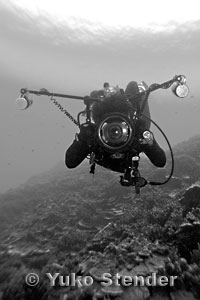| The golden rule of underwater photography is
to get as close as possible to the subject to reduce the degrading
effects of water. With that in mind it is important to use a lens
that allows you to fill the frame with a pleasing composition, working
within a few feet if possible.
Ideally you should use a
prime (non-zoom) wide angle lens for
large subjects or scenic panoramas, macro lenses for extreme closeups,
and telephoto lenses for small skittish critters. A zoom lens
allows you to switch from wide to telephoto while underwater but image
quality & low-light performance may not be as good as a prime lens. Point
& Shoot cameras can take advantage of accessory wet lenses for macro
and wide angle. Epoque
makes universal adapter rings, lenses, and trays. If
you intend to buy a full-frame DSLR at some point you cannot use any
lenses designated as 'digital-only'. Most affordable DSLR's are
APS-C format, a cropped sensor 40 percent smaller than traditional 35 x
24mm film. Full-frame lenses will work on both types while APS-C-only
models will only work on those bodies. One must also recognize
that the angle of view for a full-frame lens is decreased by roughly 40
percent when used on an APS-C camera. 
Macro
lenses are best used with flat lens ports and wide angle lenses &
zooms are used with dome ports as the dome preserves the angle of
view. Zoom lenses must be able to focus to about 12 inches or a
closeup filter will have to be attached to work properly
underwater. Note that the closeup lens will make it impossible to
focus above water and reduce image quality to some extent. |



